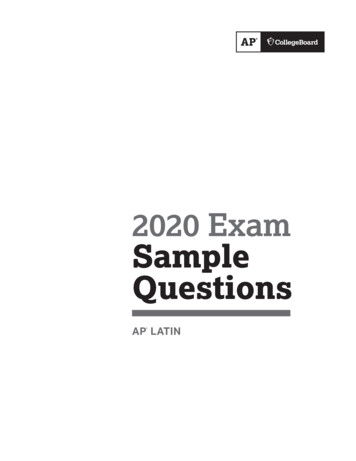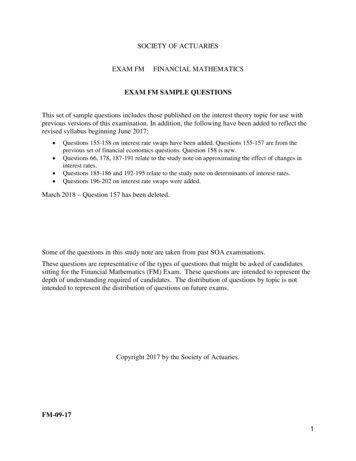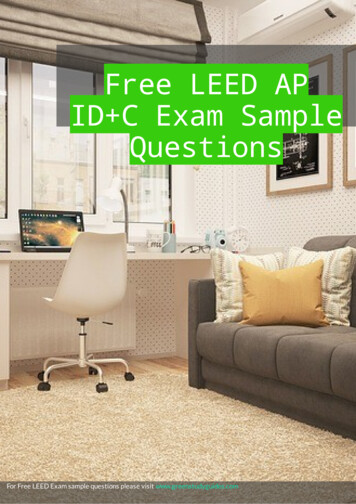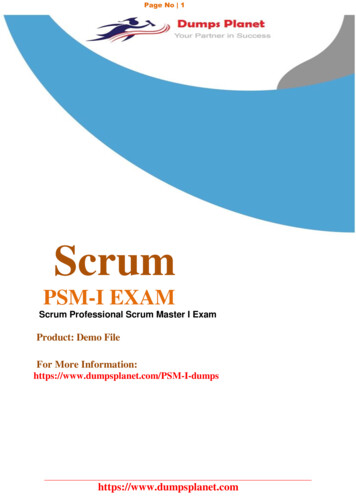
Transcription
2020 ExamSampleQuestionsAP LATIN
Notes on 2020 Exam Question 1: Short Answer:Vergil and Caesar Syllabus ReadingsAllotted time: 25 minutes (plus 5 minutes to submit)Vergil Syllabus ReadingLine5Qualis apes aestate nova per florea ruraexercet sub sole labor, cum gentis adultoseducunt fetus, aut cum liquentia mellastipant et dulci distendunt nectare cellas,aut onera accipiunt venientum, aut agmine factoignavum fucos pecus a praesepibus arcent:fervent opus, redolentque thymo fragrantia mella.“O fortunati, quorum iam moenia surgunt!”Aeneid 1. 430-437The Vergil syllabus passage of Question 1 will be of similar length to the oneabove. A total of 9 questions will follow, each worth one point. For questions with more than one part (like question (b) or (c) below), studentsmust provide all parts to earn the point. In some questions, students will be asked to write their answer in 1-2 completesentences (like question (d) below).Questions will be similar to the following examples. This is a representative, ratherthan exhaustive, list:(a) Name one and only one literary device found in line 1 AND write out theLatin word or words that illustrate it. [1 point](b) Name one and only one of the bees’ tasks described in lines 2-5 (cumgentis venientum) AND write out the Latin for that task. [1 point](c) Translate in context agmine facto (line 5) AND identify the construction. [1point](d) In what historical war were the city walls (moenia) mentioned in line 8destroyed? Answer in 1 complete sentence. [1 point]AP Latin2020 Exam Sample Questions2
Caesar Syllabus ReadingLine5His rebus adducti et auctoritate Orgetorigis permoti, constituerunt ea quaead proficiscendum pertinerent comparare, iumentorum et carrorum quammaximum numerum coemere, sementes quam maximas facere ut initinere copia frumenti suppeteret, cum proximis civitatibus pacem etamicitiam confirmare. Ad eas res conficiendas biennium sibi satis esseduxerunt; in tertium annum profectionem lege confirmant. Ad eas resconficiendas Orgetorix deligitur. Is sibi legationem ad civitates suscepit.Bellum Gallicum 1. 3The Caesar syllabus passage of Question 1 will be of similar length to the oneabove. A total of 9 questions will follow, each worth one point. For questions with more than one part, students must provide all parts to earnthe point. In some questions, students will be asked to write their answer in 1-2 completesentences (like question (d) below).Questions will be similar to the following examples. This is a representative, ratherthan exhaustive, list:Answer the following questions in English unless the question specifically asksyou to identify Latin words.(e) Identify the grammatical construction of ut suppeteret (lines 3-4). [1point](f) Translate the phrase Ad eas res conficiendas (line 6) and identify the verbform of conficiendas. [1 point](g) To whom does sibi (line 6) refer? [1 point](h) What is one reason Caesar gives later in the Bellum Gallicum for attackingthe Helvetians? Answer in 1-2 complete sentences. [1 point]AP Latin2020 Exam Sample Questions3
Notes on Exam Question 2: Short Answer:Vergil Sight ReadingAllotted time: 15 minutes (plus 5 minutes to submit)Line 5“Ventum ad supremum est. Terris agitare vel undisTroianos potuisti, infandum accendere bellum,deformare domum et luctu miscere hymenaeos:ulterius temptare veto.” Sic Iuppiter orsus;sic dea summisso contra Saturnia vultu:“Ista quidem quia nota mihi tua, magne, voluntas,Iuppiter, et Turnum et terras invita reliqui.”Aeneid 12. 803-809The passage for Question 2 will be of similar length to the one above and will betaken from the works of Vergil. A total of 7 questions will follow, each worth onepoint. For questions with more than one part, students must provide all parts to earnthe point. For some questions, students will be asked to write their answer in 1-2complete sentences.Questions will be similar to the examples listed above for Question 1.AP Latin2020 Exam Sample Questions4
Notes on material included in 2020 AP Latin ExamThe AP 2020 Latin Exam will cover the following required readings from theAP Latin syllabus (Units 1-4):Vergil, AeneidLatin text:Book 1: Lines 1-209, 418-440, 494-578Book 2: Lines 40-56, 201-249, 268-297, 559-620English translation:Books 1 and 2Caesar, Gallic WarLatin text:Book 1: Chapters 1-7Book 4: Chapters 24-35, and the first sentence of Chapter 36Book 6: Chapters 13-20English translation:Book 1Skills assessed on the AP 2020 Latin Exam:Reading and Comprehension1.C: Use specific terminology to identify grammatical forms and syntacticstructures.1.D: Demonstrate knowledge of Latin syntax to read and comprehend Latin texts.1.G: Identify stylistic features in Latin poetry and prose.1.H: Identify references to Roman culture, history, and mythology in Latin texts.1.I: Demonstrate overall comprehension of passages in Latin texts.Translation2.A: Demonstrate knowledge of Latin vocabulary when translating Latin texts intoEnglish.2.B: Demonstrate knowledge of Latin morphology when translating Latin textsinto English.2.C: Demonstrate knowledge of Latin grammar and syntax when translating Latintexts into English.2.D: Demonstrate an understanding of differences between Latin and Englishusage when translating Latin texts into English.Contextualization3.A: Use knowledge of influential people and key historical events to demonstrateunderstanding of Latin texts.3.B: Use knowledge of Roman political ideas to demonstrate understanding ofRoman culture in Latin texts.3.C: Relate Roman cultural products in Latin texts to perspectives of Roman culture.3.D: Relate Roman cultural practices in Latin texts to perspectives of Roman culture.3.E: Use knowledge of mythology and legends to demonstrate understanding ofLatin texts.3.F: Use knowledge of authors or literary conventions to demonstrateunderstanding Latin texts.AP Latin2020 Exam Sample Questions5
Skills assessed on the AP 2020 Latin Exam: Reading and Comprehension 1.C: se specific terminology to identify grammatical forms and syntactic U structures. 1.D: Demonstrate knowledge of Latin syntax to read and comprehend Latin texts. 1.G: Identify stylistic features in Latin poetry and prose.











